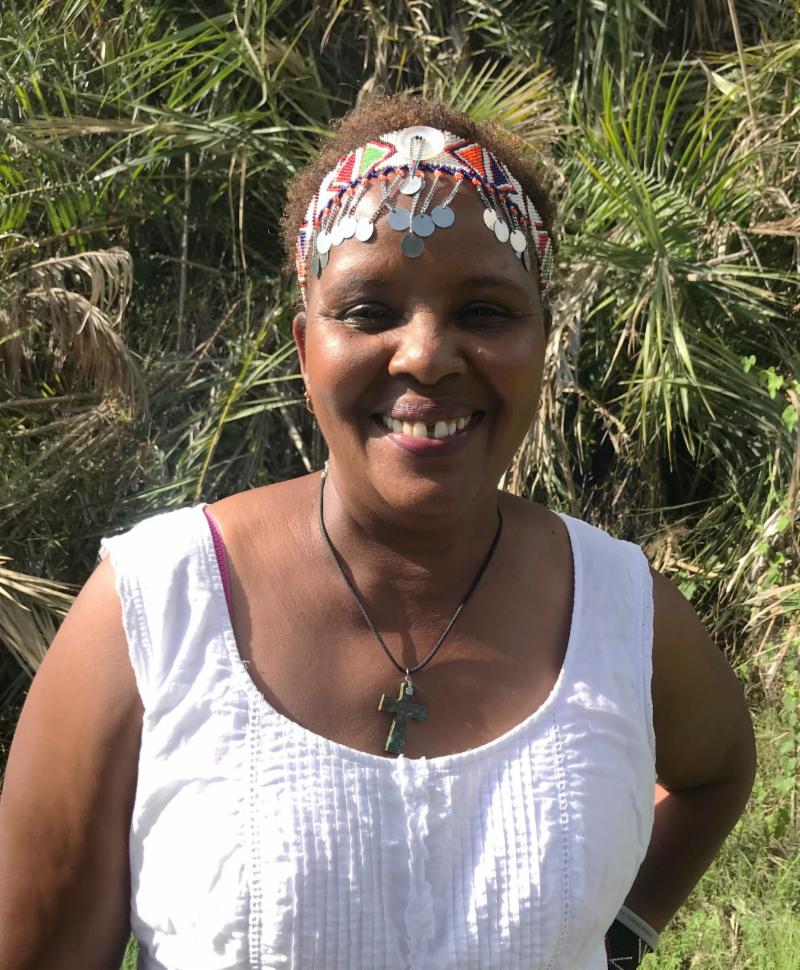
ATE's Norah Njiraini
asks you to help us in our important work
|
|
Sharing our Knowledge - Training in Amboseli
|
|
With 47 years of experience in researching elephants we have a lot to share with others working in the Conservation world.
Earlier in the year we were approached by a young passionate Maasai from Ololorashi called Losioki. Losioki is a poet and writer who is passionate about elephants and spreading the important word of environmental education among youth in the Amboseli ecosystem. He volunteers in schools and teaches Kiswahili to young Maasai. To give him a helping hand we decided to offer him free training for two days in November. This knowledge will help him when talking to children about elephants and the importance of their protection. As future custodians of Amboseli's wildlife we cannot stress the importance of this kind of outreach.
|
|
|
Norah showing Losioki our elephant jaws
|
From the 15th to the 20th of November we carried out a training course for Space for Giants (SFG). Norah and Katito trained three members of the SFG team on basic elephant aging, sexing, and data collection techniques in the field.
|
|
|
Norah with SFG staff and their certificates
|
Our training and outreach programs are reliant on your donations. Help elephants by educating those in charge of protecting them on the ground, donate to our work on the link provided in this newsletter!
|
The 11th of December was a landmark day in Amboseli. Not only did the rain pour continuously for seven hours, rather than our usual short downpours; our camp rain gauge completely filled at 100mm in just six hours. We had to empty the gauge so we could keep recording the still-falling rain, which left camp in inches of water and full of little frogs darting all over the place. Vicki got snapped demonstrating the full rain gauge to record this historic day!
Never in the entire 46 years of the project have we had this much rain in such a short period of time; almost a third of our average annual rainfall in just a few hours. We know this means the good times for the elephants will continue.
|
Thanking our Generous Donors
Jane Beckwith
David Breskin/Shifting Foundation
Born Free Foundation
Charles Colao Animal Welfare Foundation
Community Foundation of Jackson Hole
Detroit Zoo
Fair Play Foundation
Tamra and Michael Fine
Kathryn Heminway
Kristin Johnson Charitable Fund
Knox Family Foundation
John Madigan
Network for Good
Oakland Zoo
William Ralston
Gordon Ray
Gary and Kathleen Rogers Community Foundation
Susannah Rouse
Carl Safina
Gary Schudel
Maurice and
Georgina Smith
Richard Stanley
Leila and Mickey Straus Foundation
|
Graduation of Everlyne and Mercy
L-R: Everlyne, Sylvi, and Mercy
On the 14th of December Sylvi got to attend a graduation ceremony for two of our University students. Sylvi supervises all of our students, checking on their welfare and processing their paperwork with their institutions. All our students are grateful for Sylvi's support, and happy to have her attend their graduations!
We are so proud of Everylne Sialo and Mercy Kotikash for graduating from Kabarak University. They are particularly special because they are the first of our students to be supported from secondary school all the way through University. These young women are smart and hard working, and richly deserve their success. We are confident they both have bright futures ahead of them.
|
|
Ways to Support Us
Follow an Amboseli Family with Elatia
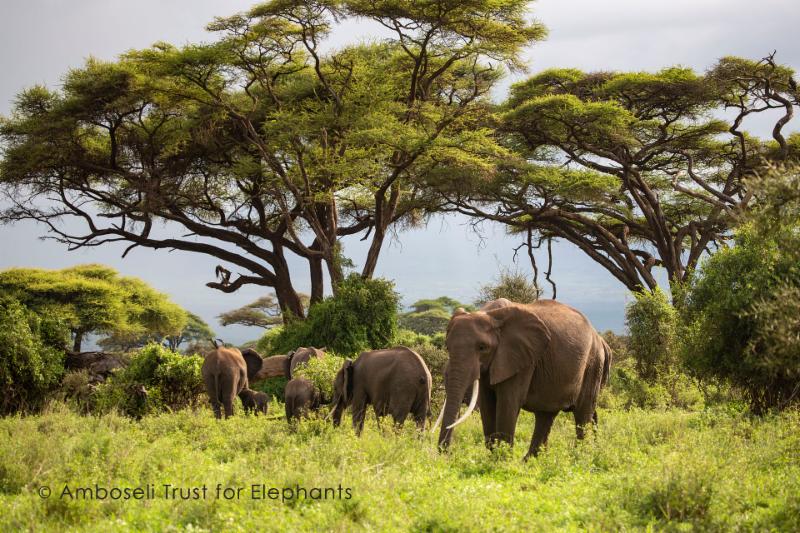
If you want an inside view of elephant lives, consider joining us to follow an elephant family in 2019. We have chosen six Amboseli families for our Elatia program: the AAs, EBs, FBs, GBs, OAs, and PCs. You can choose one or all of the families to follow. Regular updates include photos and videos, and news of what is going on in the family.
To learn more about Elatia
go to
This Link.
If you have any problems, Tal has made a tutorial for signing up,
Click Here.
You can also contact her directly if you have any questions on:
**********
Name a Baby Elephant
Would you like to have an even closer relationship with the Amboseli elephants? The best way to do so is to name one of many calves in the population.
Unlike our Elatia program where many people follow the same family, our naming program is a unique experience. The calf becomes "your" calf alone and the name you give forms a part of the Amboseli dataset for all time. For more information, please write to us at;
[email protected]
*********
iGive
One of the ways you can support ATE is by making your online purchases through iGive. If you sign up the Amboseli Trust for Elephants as your recipient organization we will get a small percentage of the sale. Connect with
iGive
.
*********
Give a Gift that Lasts Forever
Designate the Amboseli Trust for Elephants as a beneficiary of your will, individual retirement account, or life insurance policy. To learn more about planned giving opportunities, please contact Betsy Swart:
Tel +1-508-783-8308.
|
|
|
News from the Amboseli Trust for Elephants
October - December 2018
|
As we enter the New Year it is good to look back at 2018. What did we accomplish? Are we proud of the work we've done? And the most important question, are the elephants doing well? On the latter, I can say without hesitation yes, the elephants are doing very well indeed thanks to a fantastic rainfall year. There were 96 births in 2018 and of those all but four survived; a remarkable survivorship by any standard. There were only two other deaths from older calves, with no adult mortalities reported except for one poaching incident of a male we could not identify.
On the other two questions, yes; we accomplished much and we are proud of that work, although we know there is always more to do and we never rest on our laurels. In 2018 we continued the monitoring of the best-known elephant population in the world, following the lives of 1,749 individuals. We collaborated with other scientists, producing six peer-reviewed papers, with another three in preparation or review. We trained researchers and rangers from other projects. In the ecosystem, we worked closely with the Maasai community, the Kenya Wildlife Service, and other conservation organizations to help alleviate negative human-wildlife interactions. We hope to share more of this work in 2019.
Our scholarship students are thriving and we are very proud of them and what they continue to achieve. In 2018 we supported 15 students, with two of our girl students graduating
(see the sidebar).
As we do every year, we continued to spread the word about the fascinating lives of elephants and to raise the consciousness of people worldwide on the challenges that threaten elephant survival in the places they belong. Working with film crews and print journalists we have always aimed to keep up a steady flow of information resulting from the research of the Amboseli Trust for Elephants. By telling the stories of individual elephants we hope to make people care enough to take action to assure that these elephants and those living elsewhere can continue to live their remarkable lives in peace.
Cynthia Moss
Director
Amboseli Trust for Elephants
|
|
 |
Our excellent colleagues in the Amboseli Ecosystem, the Big Life Foundation, published the following amazing story, which they have kindly allowed us to reprint:
Mondays don't start much worse than this: a report received of a big bull elephant stuck in the mud deep in the Kimana swamp. Our hearts sank. Given the size, there was a small number of elephants it could be, and a small chance of a successful rescue.
An aerial view confirmed the worst: it was Tim, an icon of Amboseli and one of Africa's largest and most magnificent elephants. He was stuck in a section of deep mud, surrounded by farms and a growing crowd, and clearly in serious trouble.
Big Life rangers responded immediately, but the outlook wasn't good. Tim was up to his neck in mud and fully immobilized, with zero chance of escaping on his own. Nor was there a way for any kind of vehicle to get close enough in the swamp, either to pull him out or to dig around him. Failure-Tim's death-was suddenly an even more real possibility.
Regardless, everyone got to work. This was a challenge of physics: how to pull a 6-ton object out of a suction pit, when that object is alive, thrashing, and has no idea the people around him are trying to help. Tim was understandably aggressive and stressed, and tiring fast. Exhaustion alone can kill an animal, and it became a race against the clock to try something, anything, to save him.
The first step was to loosen the mud, so rangers knocked a hole in a concrete agricultural furrow upstream. Water flowed in, and the mud slowly started to release its grip. Tim could move a bit more, and it was helping, but it wasn't going to solve the problem.
Luckily, additional support was on the way from all over Kenya. A Kenya Wildlife Service (KWS) tractor had been steadily chugging in from Amboseli since the alert was sounded, and our friends at the David Sheldrick Wildlife Trust (DSWT), drawing from their wealth of experience, were also wrapping their heads around the tools needed to pull Tim out. The answer was going to be a very long tow strap, but that is easier said than done. We needed something 300 m long! A team got to work in Nairobi, stitching shorter straps together and then urgently sent the final product down on a private chartered flight. Meanwhile, the KWS vet, along with the DSWT mobile vet unit, were on their way from Tsavo West National Park.
Things were happening, but would the plan work? The tractor got as close as it dared, which was a farm about 100m away. The team struggled to get the straps onto Tim, somehow persuading him to lift his head and then slipping the straps underneath. Finally, they were ready. The tractor pulled, and the wheels spun... and spun... and spun. The ground was too soft, and it wasn't going to work. Another approach was needed.
The tractor set off around the swamp to try and approach from the other side. The land there was drier and firmer, but the closest point of approach was now more than 300 m away from Tim. Time ticked by as the tractor slowly drove around, and an hour later, things were in place again. Now there was space to add some extra horsepower, and two Big Life Land Cruisers lined up in front of the tractor to assist. Together, the three machines pulled, the tow strap went tight, Tim shifted slightly, and then... the strap snapped.
It was disappointing, but there was still a ray of hope. Again the vehicles pulled, again there was a slight shift, but again the strap snapped. Eventually, five strap breakages later, Tim had been repositioned and pulled out of the deepest section. Everyone was exhausted by this stage, human and elephant alike. Ten hours in the baking sun had taken its toll, but adrenaline kept the teams going. Victory felt possible; our work would not be in vain.
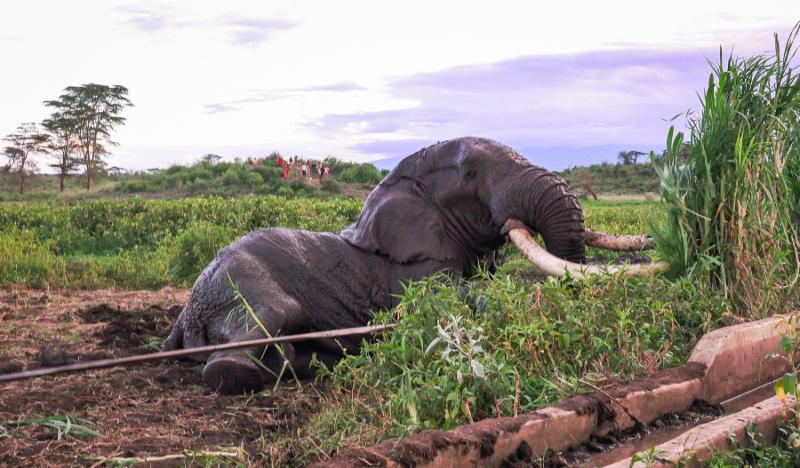
After more pulling, and even more strap breakages, the tractor and vehicles finally managed to pull Tim 25 m across the muddy ground and onto firmer footing. Once there, he was too worn out from the ordeal to even stand.
The vehicles kept pulling slowly, trying to help him up, knowing that his life depended on it. And finally, in the last light of the day, Tim stood up. Met by cheers from everyone present, he shrugged the tow straps off before slowly heading back toward the Kimana Sanctuary. The rangers stayed with him until 11 pm, ensuring that he was safely back on protected land, before calling the long day over.
*********
Tim has been closely monitored ever since and he seems to be just fine. We at ATE are so thankful to the Big Life Foundation, the David Sheldrick Wildlife Trust, Kenya Wildlife Service, East African Canvas and all the people who helped to rescue this iconic elephant.
|
|
The Loss of a Conservation Hero
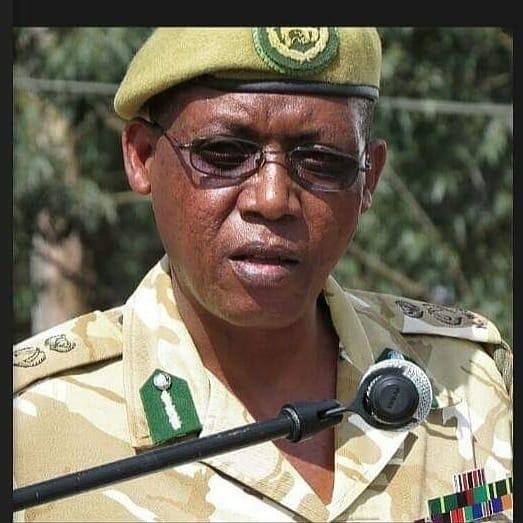
Just before Christmas a good friend of ATE's died. Julius Kimani dedicated his life to wildlife conservation working for the Kenya Wildlife Service for more than 30 years. Promoted many times for his excellent work, he was several times made Acting Director General of KWS, but each time they tried to give him the permanent post he declined. He wanted to be closer to the
field and at his death he had the job he wanted as Director of Parks and Reserves. On a personal level we first met Kimani in 1996 when he was an Intelligence officer and our camp had been raided. He was tasked with investigating the incident and it was soon obvious that he was very skilled at this job. From that point on he has been a friend to us and we will miss him greatly. Our condolences to his wife, three sons and extended family. RIP.
|
Maasai Olympics
On the 15th of December we had the great pleasure of attending the 2018 Maasai Olympics organized every two years by Big Life Foundation. This event celebrates Maasai culture while maintaining a strong conservation education message of taking part in sport without killing wildlife. It has long been the tradition of Maasai men to show their strength and bravery by hunting lions using spears. This practice in today's world has become a threat to the survival of lions, simply put: too many people and too few lions. The sports all involve things that the Maasai carry out when hunting: running events, spear throwing (javelin throw), rungu throw (precision throwing), and high jump (normally when celebrating). The competition is high and members from all around the Amboseli Ecosystem attend, making this a fun and educational day to remember.
This year there was an award for Conservation, which went to Rombo Group Ranch, and the overall athletic event was won by Mbirikani Group Ranch.
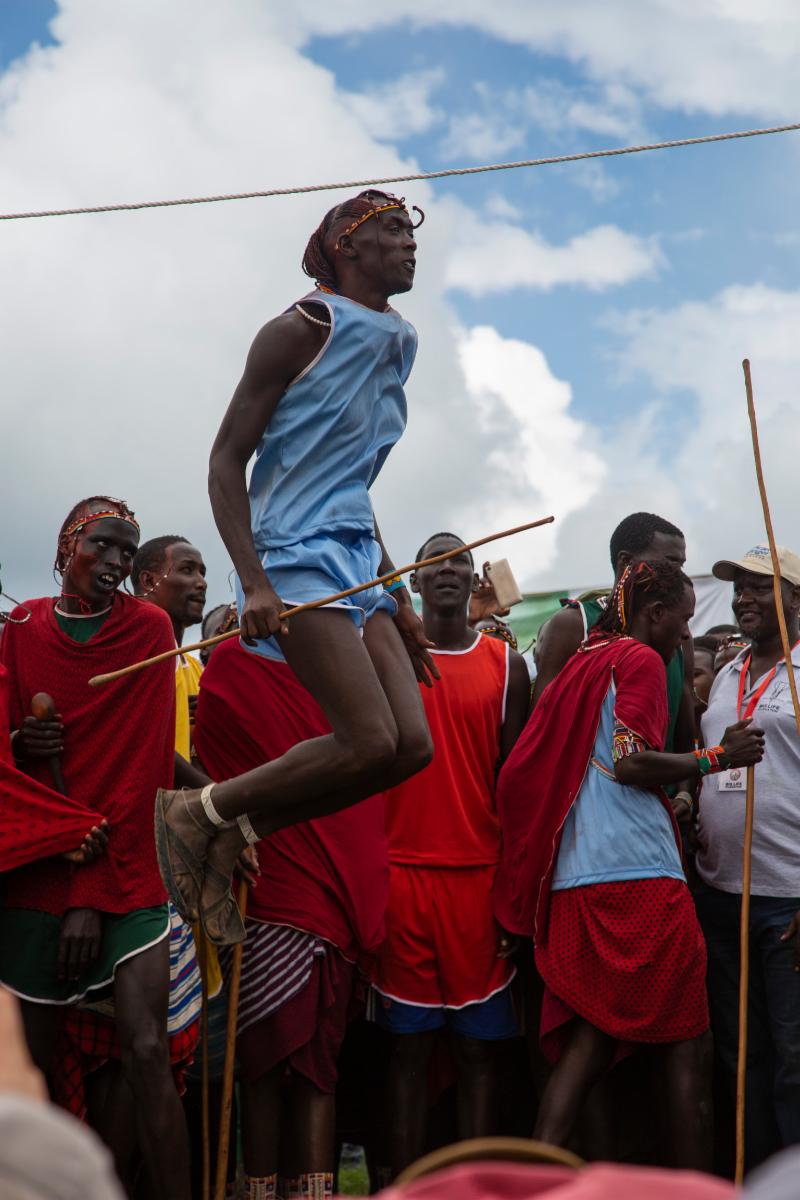 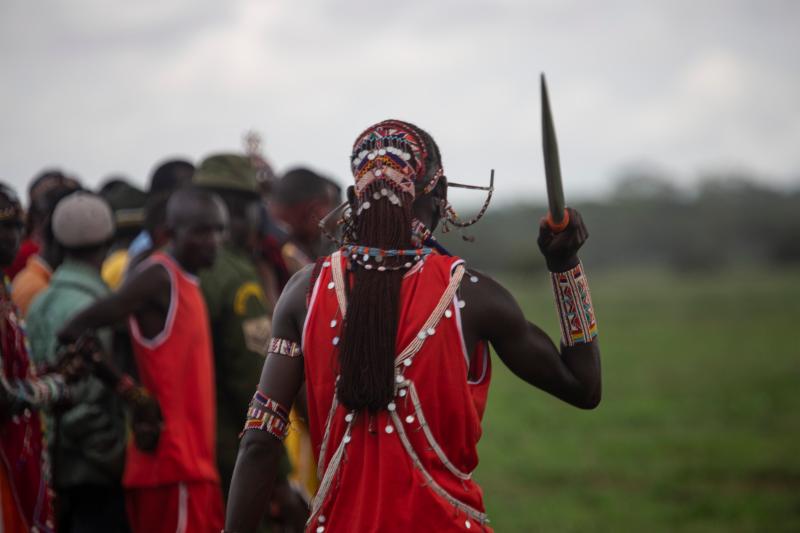 
|
|
The History of the LB Family
The LB family is one of the biggest and in some ways the most successful of any family in Amboseli. It was one of the immigrant groups that moved into the central region in the late 1970s, and therefore, it appeared to be at a disadvantage in the competition with the resident groups. I saw the family for the first time on February 9, 1976. Most of the other Amboseli families had been photographed and sighted many times by this date, thus it was a surprise to find this new family. On that occasion there were 17 animals present, including two large adult females, one with two broken off tusks and another with a large bump under her tail. There were also five young females, fortunately all with distinctive features. They had large tears out of their ears or broken tusks and one was tuskless. In addition, there was an adolescent female with a neat V out of the top of her right ear, and several young males. Oddly there were few calves: I only noted one calf und
er the age of four years old.
|
|
 |
|
The bump-tail female was named Leticia and she went on to lead her family for 32 years
|
 |
I saw this family two more times in February, and two times each in March and April. Every time I saw them, including the first, they were very wary of my car, either running away when I approached or getting into defensive formation. This behaviour indicated that
they were not used to being in the central tourist area of Amboseli. I did not see them again until October 1976 and on that occasion they were ex
tre
mely agitated. Th
ey were also missing the broken two-tusked female. I never saw her again. However, from that day on, the family, designated the LB group, was sighted regularly on a monthly basis. I believe the core of their home range had been one of the swamps to the east of the Park and that they were forced to leave when people began to cultivate in the area. Broken Two Tusks was probably killed in a conflict with the farmers. Four other families appeared to move in at the same time. All became permanent residents in Amboseli and eventually began to calm down and tolerate vehicles.
|
|
|
Happy New Year friends and supporters. We greatly appreciate all that you do for ATE and for elephants.
We look forward to another year of revelations about the intriguing lives of African elephants.
|
|
|